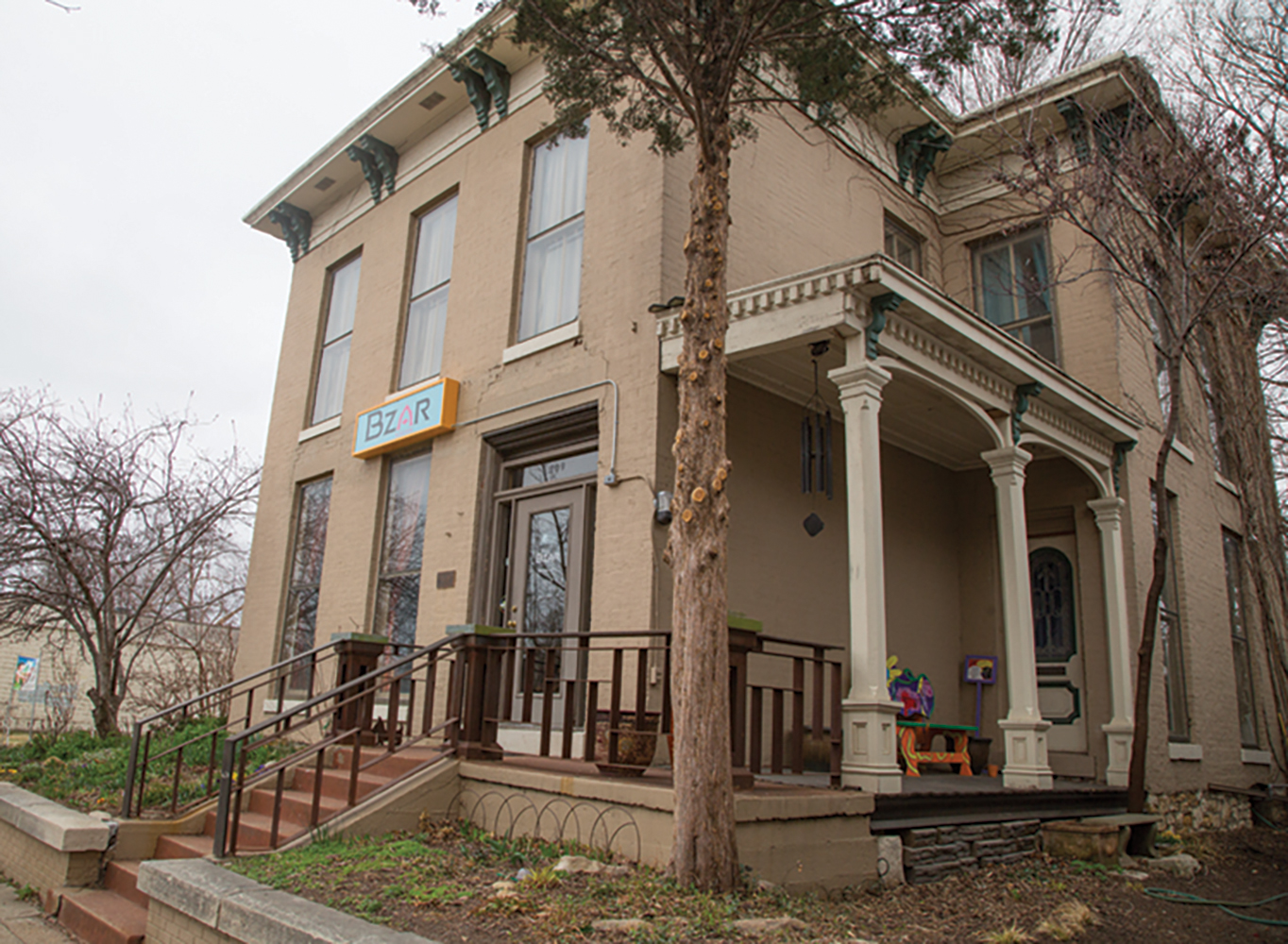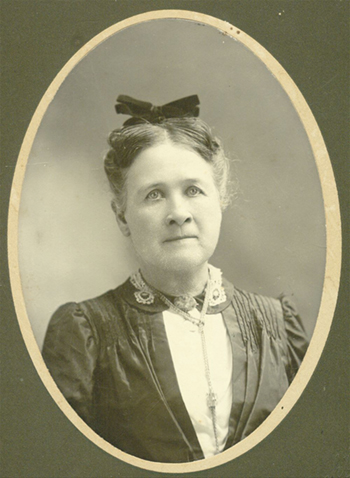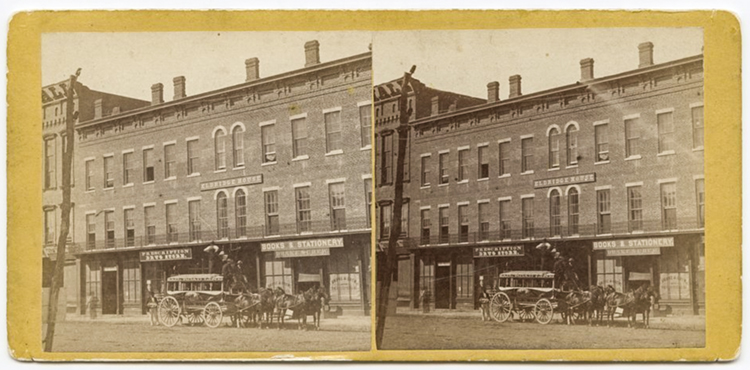Lawrence Buildings have a History.
| 2017 Q1 | story by Patricia A. Michaelis, Ph.D.,, new photos by Steven Hertzog,
historical photos from the Kansas State Historical Society, kansasmemory.org

Lucy Hobbs Taylor office building at 908 Vermont, currently home to BZAR
Surprisingly, only a few “historical places” are business structures. The Watkins Bank building, built in 1887, started life as the offices of Jabez Watkins, who operated a land mortgage company on the second floor and later opened the Watkins National Bank on the first floor. The building later served as the Lawrence City Hall and now is the home of the Douglas County Historical Society. The industrial structure at 546 New Hampshire housed the Consolidated Barb Wire Company and later the Lawrence Paper Company. The stone and brick three-story House Building, another historic structure located at 729-731 Massachusetts St., was built by Josiah Miller in two stages that were completed in 1858 and 1860. The post office was located in the building, briefly, during the territorial period. By 1862, Jacob House operated a men’s clothing store in the south building. Numerous businesses have been located on the site, including House Clothing, a “Dry Goods and Groceries,” a billiards parlor with offices for lawyers and a dentist on the second floor. An extensive renovation by Mr. House’s daughter-in-law removed the third floor.
This article will focus on two of the structures on the National Register with great historical significance for their association with Bleeding Kansas, the Civil War, and women’s history.

Lucy Hobbs Taylor
The building at 809 Vermont St. served as the home and office of Lucy Hobbs Taylor, the first woman in the United States to graduate from a dental college as a “Doctor of Dental Surgery.” Lucy Beamon Hobbs was born in upstate New York on March 14, 1833. After graduation from Franklin Academy, she taught school in Brooklyn, Michigan, for approximately 10 years. While in Brooklyn, she boarded with a physician and began reading medical textbooks in her free time. This lead her to pursue a career in medicine at a time when medical schools of any sort rarely accepted female students. She applied to the Eclectic Medical Institute in Cincinnati, Ohio, but as she arrived, the school decided it would not accept female applicants. The founder of the college, Dr. Charles Cleaveland, suggested that Lucy consider a career in dentistry, which he viewed as an easier road to success.
Even this route was challenging. While still in Cincinnati, she was accepted to study part-time by Dr. Jonathan Taft, a physician, surgeon and dentist. He helped her arrange a one-year apprenticeship with Dr. Samuel Wardle. After unsuccessfully applying to attend the Ohio College of Dental Surgery, she opened her own practice in Cincinnati in 1861. Having difficulty acquiring patients, she moved to Iowa in 1861 and practiced for a short time in Bellevue and McGregor. Lucy became the first woman to receive full membership in a professional dental association when she became a member of the Iowa Dental Society in 1865. This was in spite of her lack of formal training. The Society also nominated her as one of their representatives to the American Dentists convention in Chicago. The Iowa Society passed a resolution that Lucy Hobbs should be admitted to the next class of the Ohio College of Dental Surgery or they would withdraw from membership in the convention.
The resolution was successful because, after being examined by the college’s professors, she was placed in the senior class as the only woman of the 19 students. Lucy was 32 years of age and had been practicing dentistry for five years. She had the highest grades in her class, and, after graduation, in February 1866, she set up practice in Chicago, Illinois. There, she met her future husband, James Taylor, and they were married in 1867. After moving to Lawrence, Kansas, that same year, they announced the opening of a new office in April, 1871, at 49 (now 809) Vermont St.. It also served as their home until 1881. They moved the dental practice to a commercial building at 8th and Massachusetts streets. James Taylor died in 1886, and Lucy retired in 1887, selling the Vermont Street building and closing the Massachusetts Street office. In 1895, Lucy repurchased the 809 Vermont St. building and practiced there on a part-time basis until her death on Oct. 3, 1910. Not surprisingly, after retirement, she was active in the women’s rights movement in Kansas.
Today, it is difficult to understand all the obstacles Lucy Hobbs Taylor encountered while pursuing the education necessary for her career as a dentist and in practicing dentistry. She was a pioneer and a woman of perseverance.
The structure at 809 Vermont has served as a veterinary hospital and a hair salon. The exterior structure is virtually intact, though renovations have been made to the interior.
Perhaps more than any other business in Lawrence, the Eldridge House is associated with the early history of the community. The site of the current building, 733 Massachusetts St., which was constructed between 1925 and 1928, was the site of three previous structures—the Free State Hotel and two Eldridge House hotels. The earliest buildings seem to have been called both the Eldridge House and the Free State Hotel.

Eldrige House
The Eldridge House (1855-56) was built under the auspices of the New England Emigrant Aid Company by Shalor Eldridge. It was a boarding house as well as a hotel, and the “Rules and Regulations” printed May 10, 1956, included information that rooms were to be locked when residents left and their keys left at the office, anyone staying less than a week had to pay in advance, all gambling was prohibited and the House closed at 11 p.m.
The Eldridge House was destroyed in May 1856 by proslavery forces led by Sam Jones, the sheriff of Douglas County. It was rebuilt and reopened in late 1858. John J. Ingalls, writing to Elias Ingalls on Jan. 2,1859, included this description in the letter:
- There are some good residences in the town, some fair business block, and the best hotel west of the Ohio. It is called the “Eldridge House,” after its proprietor, and was opened on Friday Evg. by a New Year’s inauguration ball. It is built of brick with all the appointments of a first class house and cost $75,000.
Various social events were held at the hotel including the ball mentioned by Ingalls and one to benefit the Lawrence Fire Department held on the anniversary of the destruction of the hotel in 1856.
This incarnation of the Eldridge House was destroyed during Quantrill’s proslavery raid of Lawrence on Aug. 21, 1863. Much of Lawrence was damaged or destroyed, and 150 people were killed. In September 1863, leading citizens of Lawrence signed a petition stating the following:
- The Free State Hotel is again in ruins by the hands of Proslavery fiends. We your neighbors and friends appeal to You not to be discouraged but arouse Yourself to action and rebuild the noble structure as near as possible as it was. We will aid you to the utmost of our ability and firmly believe the friends of freedom throughout the land will aid You. We respectfully urge You to visit those friends throughout the States & give them the opportunity of contributing. We know they will aid in the erection of such a monument to Freedom.
A second petition urged the City of Lawrence to provide $10,000 in bonds to assist in the rebuilding of the hotel.
The rebuilt three-story Eldridge House opened in 1866 and remained a fixture in Lawrence until 1925, when it was demolished to be replaced by a new hotel structure. Many in Lawrence were opposed to the destruction of the 1866 structure, but the Lawrence Chamber of Commerce promoted the new hotel with slogans like “Every citizen a stockholder, every citizen a ‘booster’ ” and ‘The modern hotel of any city is the organized host of the community.’ ” The stock prospectus stated that, “Lawrence would no longer be shunned by travelling salesmen.” The new Eldridge Hotel had 150 guest rooms, all of which had toilets and sinks, and about half had baths. The National Register nomination form described room furnishings.
- The typical guest room included a walnut finished steel bed with double deck springs and a spring cushion mattress a night stand with a reading lamp attached to it, and a five-ply walnut dresser designed by [William] Hutson. To make the hotel more desirable to salesmen, there were eight combination sample rooms of the second floor of the northern unit.
The current Eldridge Hotel building, a five-story, brick, eclectic Second Renaissance Revival structure, is listed on the National Register of Historic Places for its historical and architectural significance and for its association with William Groh Hutson, a Lawrence native who achieved national prominence in the hotel industry.




4 Comments
Having read this I thought it was extremely enlightening.
I appreciate you finding the time and energy to put this article together.
I once again find myself personally spending way too much time both reading and leaving comments.
But so what, it was still worthwhile!
142668 852442Greetings! This is my 1st comment here so I just wanted to give a quick shout out and tell you I genuinely enjoy reading by way of your blog posts. Can you recommend any other blogs/websites/forums that deal with exactly the same topics? Thank you so a lot! 452334
This is my first time go to see at here and i am actually happy
to read all at single place.
I’m curious to find out what blog platform you are utilizing?
I’m having some small security problems with my latest blog and I
would like to find something more risk-free. Do you have any suggestions?